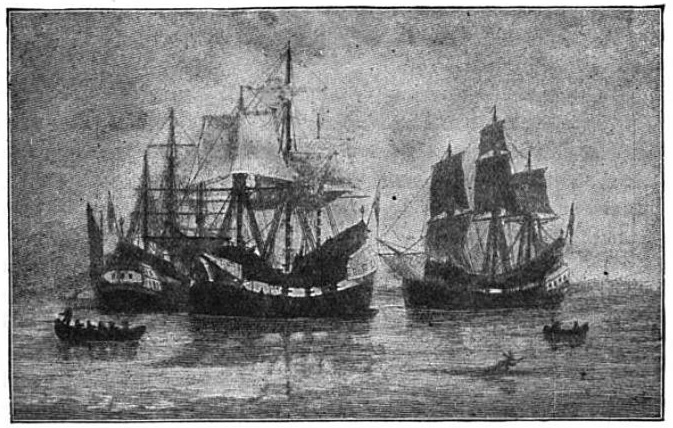
The battle of Mayaguez bay between the British frigate Glasgow and the North American schooners endowack and the Henry April 1777 where Puerto Rico helped the American vessels thus becoming the first nation to recognize the sovereignty and flag of the United States
Little known crucial intervention of Puerto Rico
In the 1775 independence war of the United States
This is a true fact that has never been recognized
Rafin R. Mena
Yes it is generally unknown; but Puerto Rico in fact, had for sure, a significant role in the United States´ war of independence from Britain in 1777. Intervention for which, it has never been recognized and much less thanked.
It all happened back in the fourteen of April, 1777 at the old port of San German in Mayaguez Bay, located in the West coast of the island. And it occurred at a moment which cannot have been more urgent and critical, for George Washington's war efforts. Britain had, almost all North Atlantic sea routes, sealed and blocked with a fleet of heavily armed war ships. The Continental Army, fighting a desperate war against this most powerful nation of the time, was in dire and desperate need for the weapons and war stores, necessary to face it. Reason for which, the great commander, had commissioned a number of the only available small and medium size schooners and sloops, to make the run to South America-specifically: Curacao-- breaking the blockade and retrieve and bring back the stores and weapons acquired there. It was really a matter of life and death for the incipient revolution, and it had to be carried out no matter what, regardless of its cost.
One of these American small vessels: the sloop barge Henry, was able to do just that. Fooling the blockade, had been able to sail to Curacao, load the weapons and was sailing back to Virginia to deliver its cargo when near Mona Passage, between Hispaniola and the West coast of Puerto Rico, was intercepted by the British war frigate the Glasgow. The Henry, being a gaffed sails rigged sloop, even when heavy loaded, was able to out maneuver the Glasgow, which with square rigged sails, was much slower to do likewise. On they went all the way, with the Henry close beating windward and tacking all the time, and in close pursue, the Glasgow until they reached the protected waters of Mayaguez bay, wherein, the Henry was beached and its cargo unloaded. Her master, one Amos Weeks, then asked the local military Puerto Rican port authorities for protection. The Glasgow. had by then too, put out one of its tender skiffs, and, was approaching said anchorage, with an armed detachment of seamen and their officer, to request the surrender of the Henry's men and cargo.
It was the morning of April fourteen, 1777. A stand still then ensued, because aside the unusual occurrence, the harbor master: Captain Faustino Martinez de Matos, was somewhere else out of town, and only his lieutenant Bernardo Zeno was available. It was a moment of tremendous tension and expectations as anyone can imagine, with the Glasgow's men adamantly pressing their request with weapons loaded, ready and pointing, and the Henry's people with cargo littering the beach, desperate for a solution. Luckily, the Harbor master finally arrived and decided to grant military protection to the Henry's men and cargo; requesting besides, to the Glasgow detachment, to go back to their ship. He then proceeded to notify the Governor of Puerto Rico in San Juan: don Juan Duffresne, who not only instructed him to officially grant the military protection but also to request the Glasgow to abandon the bay and to return anything taken from the Henry. The Henry remained in Puerto Rico for a while, repaired their tackle, and when they were ascertained that the Glasgow had abandoned the area´s waters, sailed out and delivered the desperately needed weapons.
Four months later, the first of August, again two American Colonial ships arrived at the Mayaguez harbor chased by the Glasgow, which had obviously laid in wait somewhere in the Caribbean Islands. This time, in addition to the Henry, the Schooner Endowack had made the run to Curacao and loaded with war stores and guns, where in the process to deliver them in Virginia. Knowing the local authorities´ predisposition towards them, they dock in said port with the Glasgow who decided this time to capture them no matter what, maneuvering broadside, very close to the shore, to be with their guns within range of the American vessels. In view of this, and expecting the worse, the Puerto Rican authorities, raised Spanish flags on both American vessels to avert their destruction; believing that the British, cognizant of Spain´s neutrality in that war, would not dare attack neutral vessels. The gambit worked and the Glasgow apparently confused and not knowing what to do, simply abandoning the chase, left the bay.
The town´s folks welcomed the men and officers of both vessels, of which they were familiar with captain Amos Weeks and sailors of the Henry. They were fed and taken care of, until they decided to go back again to Virginia with the armament.
How many people know this? Where or when, has it been mentioned? And more curiously, why has it been kept out of the history of the United States Independence war? Regardless of this, there is an indisputable fact: THE UNITED STATES OF AMERICA HAS A BIG DEBT OF GRATITUDE WITH THE PEOPLE OF PUERTO RICO.
Article Source: http://EzineArticles.com/9923992

No comments:
Post a Comment